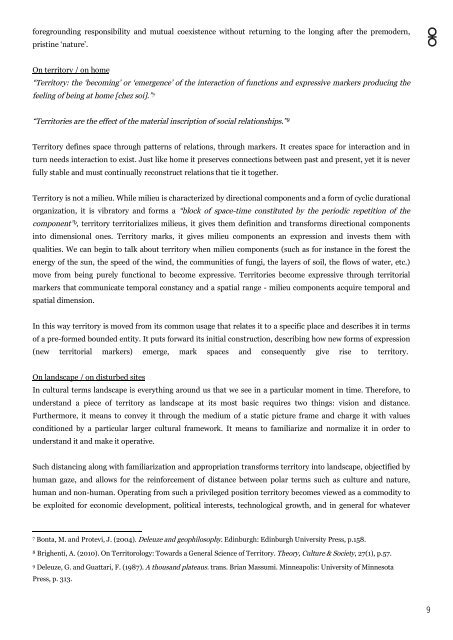Unfamiliar Territory_Research
You also want an ePaper? Increase the reach of your titles
YUMPU automatically turns print PDFs into web optimized ePapers that Google loves.
foregrounding responsibility and mutual coexistence without returning to the longing after the premodern,<br />
pristine ‘nature’.<br />
⚮<br />
On territory / on home<br />
“<strong>Territory</strong>: the ‘becoming’ or ‘emergence’ of the interaction of functions and expressive markers producing the<br />
feeling of being at home [chez soi].” 7<br />
“Territories are the effect of the material inscription of social relationships.” 8<br />
<strong>Territory</strong> defines space through patterns of relations, through markers. It creates space for interaction and in<br />
turn needs interaction to exist. Just like home it preserves connections between past and present, yet it is never<br />
fully stable and must continually reconstruct relations that tie it together.<br />
<strong>Territory</strong> is not a milieu. While milieu is characterized by directional components and a form of cyclic durational<br />
organization, it is vibratory and forms a “block of space-time constituted by the periodic repetition of the<br />
component” 9 , territory territorializes milieus, it gives them definition and transforms directional components<br />
into dimensional ones. <strong>Territory</strong> marks, it gives milieu components an expression and invests them with<br />
qualities. We can begin to talk about territory when milieu components (such as for instance in the forest the<br />
energy of the sun, the speed of the wind, the communities of fungi, the layers of soil, the flows of water, etc.)<br />
move from being purely functional to become expressive. Territories become expressive through territorial<br />
markers that communicate temporal constancy and a spatial range - milieu components acquire temporal and<br />
spatial dimension.<br />
In this way territory is moved from its common usage that relates it to a specific place and describes it in terms<br />
of a pre-formed bounded entity. It puts forward its initial construction, describing how new forms of expression<br />
(new territorial markers) emerge, mark spaces and consequently give rise to territory.<br />
On landscape / on disturbed sites<br />
In cultural terms landscape is everything around us that we see in a particular moment in time. Therefore, to<br />
understand a piece of territory as landscape at its most basic requires two things: vision and distance.<br />
Furthermore, it means to convey it through the medium of a static picture frame and charge it with values<br />
conditioned by a particular larger cultural framework. It means to familiarize and normalize it in order to<br />
understand it and make it operative.<br />
Such distancing along with familiarization and appropriation transforms territory into landscape, objectified by<br />
human gaze, and allows for the reinforcement of distance between polar terms such as culture and nature,<br />
human and non-human. Operating from such a privileged position territory becomes viewed as a commodity to<br />
be exploited for economic development, political interests, technological growth, and in general for whatever<br />
7<br />
Bonta, M. and Protevi, J. (2004). Deleuze and geophilosophy. Edinburgh: Edinburgh University Press, p.158.<br />
8<br />
Brighenti, A. (2010). On Territorology: Towards a General Science of <strong>Territory</strong>. Theory, Culture & Society, 27(1), p.57.<br />
9 Deleuze, G. and Guattari, F. (1987). A thousand plateaus. trans. Brian Massumi. Minneapolis: University of Minnesota<br />
Press, p. 313.<br />
9


